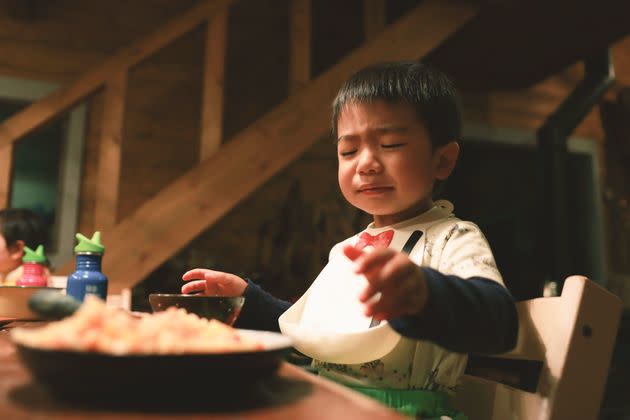PSA, Popcorn Can Be Really Dangerous For Little Kids

When it comes to choking hazards in kids, you typically think of firm, round items like grapes, blueberries and those circular batteries in toys.
But it turns out popcorn is also high up on the list of choking risks for nippers – as one mortician and mum recently explained on Tiktok.
Lauren Eliza, a mortician from the US, said: “If something makes my list of things I do not keep in my home, you know it is a bad one.
“Giving your children popcorn is one of the quickest ways you can get a ride in an ambulance.”
@lovee.miss.lauren Replying to @jessicaclucente EDUCATIONAL CONTENT ✨🍿 Call me the grinch. But my toddlers don’t eat popcorn. Chronicles of the Scarred Mortician continue. #mortician#educationaltiktok#funeraldirector#popcorn#hatehatehate#deathtok#BeTheReasonVisa#HuluChippendalesDance#scarredforlife#grinch#christmas#greenscreen
♬ Chopin Nocturne No. 2 Piano Mono - moshimo sound design
The reason they’re so problematic, she explained in the video which has been viewed 480,000 times, is because of the little kernels in them.
These kernels are so lightweight they can “easily” be sucked up back into their oesophagus, she said, and children can either breathe them in, called aspiration, or they can choke – which is where the airway is blocked.
She added that it doesn’t even matter if you’re supervising your child eating popcorn, it can still happen.
“The super scary thing about it is you can’t get it out,” she said of the snack. “The irregular shapes and dry texture of popcorn makes it super easy to get stuck.”
In the UK, around 40 under-fives are rushed to hospital every day after choking or swallowing something dangerous.
Food is often the most likely cause, according to CE Safety, which suggests kids don’t master the chewing and swallowing technique until they’re about five years old. Perhaps unsurprisingly, popcorn made its list of worst offenders.
Other choking hazards, according to Tiny Hearts, which educates parents on keeping children safe, include: grapes, cherry tomatoes, blueberries, nuts, raw carrot, apple, chewing gum, coins, marbles and batteries.
“The greater the roundness, firmness or slipperiness of an object, the greater the choking risk,” they explain.
The general consensus is that kids can start having popcorn after the age of four – but some parents might want to hold off for longer.
If your child does get something stuck while eating, here’s what you need to do next.
How to treat a child who is choking
“Sometimes choking is caused when someone laughs suddenly whilst eating and is usually dislodged quickly by coughing,” Kate Naylor, founder of Bumps & Bashes, an online first aid training course for parents, tells HuffPost UK.
“If someone can make a noise, that means they can breathe and it’s a partial choke. If someone is silent that means there’s a complete blockage and the airway is blocked. Silence is scary and this is the time to step in quickly and help.”
Try to remember three key actions, says Lydia Scroggs, who is head of clinical operations for St John Ambulance. They are: cough it out, slap it out and squeeze it out.

Cough it out
Encourage them to cough and remove any obvious obstruction from their mouth.
Slap it out
Naylor recommends holding your child’s head with your hand on their jawline. “Their body should be lower than their feet for gravity,” she explains.
Now give up to five sharp back blows with the heel of your hand between their shoulder blades.
After each back blow, Scroggs recommends checking their mouth for the obstruction.
“Do not sweep the mouth as this could push the object further down the throat,” she adds.
Squeeze it out
If back blows don’t work, move onto this next step. Although what you do will depend on how old your child is.
For older children, give five abdominal thrusts by standing behind them and putting your arms around the child’s waist, says Scroggs.
“Place one hand in a clenched fist between their belly button and the bottom of their chest. With your other hand, grasp your first and pull sharply inwards and upwards up to five times,” she explains.
If your child is a baby or young toddler, Naylor recommends turning them over in your lap so they’re facing upwards and using your hand to support their head and neck.
They should be positioned with the head lower than their body, so you can be looking in their mouth.
“With two fingers in the centre of their chest (make an imaginary line across the bottom of their armpits), give up to five chest thrusts,” she says, “like a stabbing motion with your fingers.”
If they are still silent, make sure an ambulance has been called and repeat the process whilst waiting with five back blows and five chest thrusts each time.
She notes that the minute a noise is made, this indicates the blockage has been removed, but you should definitely get them checked out by a doctor after performing the technique.
If they become unresponsive at any point, you will need to perform child CPR.
Related...
'My Daughter Couldn’t Speak Until She Was Six, But She Knew Exactly What She Wanted To Say'
I Tried This Insta-Hack For Cleaning My Toddler's Teeth And It Actually Worked
Single Parents Are Having To Make Impossible Decisions This Winter
If You're A Parent Who's Worried About Strep A Right Now, You're Not Alone
You Probably Shouldn't Say These Things To Kids At Christmas

 Yahoo Movies
Yahoo Movies 